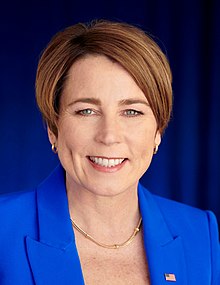| Governor of the Commonwealth of Massachusetts | |
|---|---|
 Seal of the governor | |
 Standard of the governor | |
since January 5, 2023 | |
| Government of Massachusetts | |
| Style |
|
| Status | Head of state Head of government |
| Member of | Governor's Council Cabinet |
| Residence | None official |
| Seat | State House, Boston, Massachusetts |
| Nominator | Nominating petition, Political parties |
| Appointer | Popular vote |
| Term length | Four years, no term limits[1] |
| Constituting instrument | Constitution of Massachusetts |
| Formation | Original post: April 30, 1629 Current form: October 25, 1780 |
| First holder | John Endecott |
| Deputy | Lieutenant Governor of Massachusetts |
| Salary | $185,000 (2022)[2] |
| Website | Official website |
The governor of the Commonwealth of Massachusetts is the chief executive officer of the government of Massachusetts. The governor is the head of the state cabinet and the commander-in-chief of the commonwealth's military forces.
Massachusetts has a republican system of government that is akin to a presidential system. The governor acts as the head of government while having a distinct role from that of the legislative branch. The governor has far-reaching political obligations, including ceremonial and political duties. The governor also signs bills into law and has veto power. The governor is a member of the Massachusetts Governor's Council, a popularly elected council with eight members who provide advice and consent on certain legal matters and appointments.[3]
Beginning with the Massachusetts Bay Company in 1629, the role of the governor has changed throughout its history in terms of powers and selection. The modern form of the position was created in the 1780 Constitution of Massachusetts, which called for the position of a "supreme executive magistrate".[4]
Governors of Massachusetts are elected every four years during state elections that are held on the first Tuesday of November after November 1. As of November 2022, the most recent Massachusetts gubernatorial election was held in 2022. Following each gubernatorial election, the elected governor is inaugurated on the Thursday after the first Wednesday in January following the election.[5] There are no term limits restricting how long a governor may serve.[6][7][8] The longest-serving Massachusetts governor is Michael Dukakis, who served 12 years; Dukakis was in office from 1975 to 1979 and from 1983 to 1991. The current governor is Maura Healey, a Democrat who won the 2022 gubernatorial election.
- ^ "Which States Have Term Limits On Governor?". Term Limits.com. Washington, DC: U.S. Term Limits. June 3, 2020. Retrieved December 3, 2020.
Thirty-six states have some form of term limit on the office of governor. Fourteen states do not. They are: Connecticut, Idaho, Illinois, Iowa, Massachusetts, Minnesota, New Hampshire, New York, North Dakota, Texas, Utah, Vermont, Washington, and Wisconsin.
- ^ "Selected State Administrative Officials: Annual Salaries". The Council of State Governments. Retrieved August 7, 2024.
- ^ Morison 1917, p.22-28.
- ^ "Massachusetts Constitution".
- ^ William, Galvin. "Elected Officials' Effective Dates of Office". Secretary of the Commonwealth of Massachusetts. Retrieved November 6, 2022.
- ^ "A Third Term For Governor Charlie Baker?". News. June 8, 2019. Retrieved August 3, 2020.
- ^ "What Charlie Baker faces should he seek a third term". Boston Herald. July 4, 2020. Retrieved August 3, 2020.
- ^ "Term Limits on Governor". U.S. Term Limits. June 19, 2018. Retrieved August 3, 2020.
